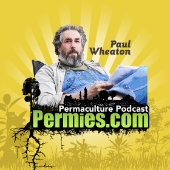Andrew Scott wrote:the design yourself out of the system concept
Hmmm. I don't know that concept and I'm pretty sure it's not a principle of permaculture. Perhaps what you're eluding to is this:
2.14 Principle Summary
A Policy of Responsibility (to relinquish power)
The role of beneficial authority is to return function and responsibility to life and to people, if succssful, no further authority is needed. The role of successful design is to create a self-managed system.
I think many people would say that one goal of permaculture is to actually do the opposite, to design the human
into the system in a way that is beneficial to the system (or the natural world if you like). I think a 'self-managed system' is intended to include humans, simply because 'function' and 'responsibility' are to be returned to life and
people. Mollison did (in one audio course I listened to) say that he was interested in designing a natural system which was abundant for itself only (excluding the human element) but that it was a sort of pet idea of his, and that designing with humans in mind was much more important given the current situation.
One quirk in the whole discussion is the differences between
-Hunter/Gathers who live on what the can hunt and gather and had a beneficial impact on the environment without actually trying (ex. Pooping in the same spot every year > growth of blueberry bushes).
-Horticulturalists who hunted and gathered but also 'horticultured' in the sense that they interacted with the environment in some way (ex. replanting blueberry bushes by taking cuttings).
-Agriculturalists who limited their diet to 14 (total) domesticated animals and 3/4 major crops (ex. blueberries are a minor crop when compared to corn, soy, and wheat).
Paleos are (I assume) shooting for the H/G approach, whereas permaculturalists are probably shooting for the Horticulturalist option. Both are suspicious of Agriculture as a concept. Both are compatible forms of interacting with the environment. Paleos or H/G are probably more interested in letting 'nature take its course' and letting nature dictate how many humans are appropriate for this planet (the number is surprisingly small, when the state of the current planet is taken into consideration) whereas permaculturalists or horticulturalists might be more inclined to believe that we can have abundant ecosystems in any place (given good design) that can support the current population or more.
There are differences to be taken into consideration but we should be striving for integration and not separation (another good principle).
Anyway,
whatever the permaculture designer wants
Wasn't said to mean that if the designer wants a parking lot, she or he should get it. It was to mean that permaculture design can take many paths. Human diet or food procurement is one function that can be designed in a myriad of ways (and functions should be supported by many elements). That might be 'paleo' for some designers of permaculture systems or not, simply because their context is different. If someone's design is situated next to a grain mill with a surplus of grain they might insert that grain as a potential element of their overall food procurement strategy, even if they would try to include more elements to support that function, like nuts, roots, and meat. Or maybe their design includes a person who really doesn't want to eat meat. That can be designed in too.
all the best,
William









